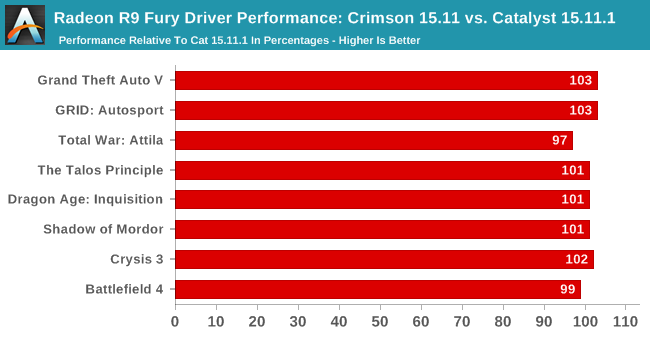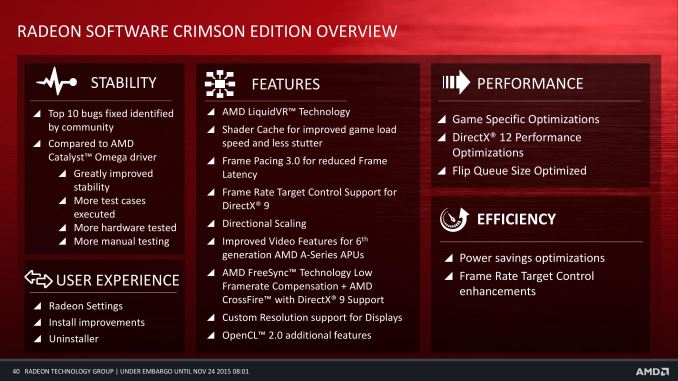AMD's Radeon Software Crimson Driver Released: New Features & A New Look
by Ryan Smith & Daniel Williams on November 24, 2015 8:00 AM ESTCrimson Performance
Last but certainly not least, let’s talk about performance improvements. Like the Omega driver before it, Crimson comes with a collection of performance improvements from AMD’s new driver branch. To preface this with caution, I don’t think anyone should be expecting massive system-wide performance gains – that’s all low-hanging fruit AMD picked long ago – but there’s plenty of room for some lesser optimizations along with game-specific optimizations.
AMD’s own numbers point to game-specific improvements of up to 20%, though it should be noted that AMD’s best-case numbers are on unreleased/beta games that have yet to be well-optimized in the first place. Otherwise AMD’s own numbers are far more tame, listing recently released games with gains between three and five percent.
To take a quick look at general performance, we went ahead and ran our GPU benchmark suite at 2560x1440 on our Radeon R9 Fury (vanilla), comparing the previous Catalyst 15.11.1 beta to the new Radeon Software Crimson 15.11 beta. The Fury and its underlying Fiji GPU is the newest product out of AMD, so it offers AMD the best opportunity to unlock any remaining performance in the architecture.

Overall the average performance gain at 2560x1440 is just 1%. There are a couple of instances where there are small-but-consistent performance gains – Grand Theft Auto V and Grid: Autosport stand out here – but otherwise the performance in our other games is within the margin of error, plus or minus. Not that we were expecting anything different as this never was pitched as a golden driver, but this does make it clear that more significant performance gains are going be on a per-game basis.
Final Thoughts
Wrapping things up, AMD’s development structure in the past year and going forward is one that has both been beneficial to the company and has brought with it its own drawbacks. By focusing feature releases around the end of the year driver, AMD is able to cut down on what parts of the driver they change (and thereby can possibly break) at other times of the year, and try to knock out all of their feature-related bugs at once. At the same time it makes the annual driver release a significant event, as AMD releases a number of new features all at once. However on the other hand this means that AMD has few features launching any other time of the year, which can make it look like they’re not heavily invested in feature development at those points. Then of course there’s the WHQL element, where for multiple reasons AMD hasn’t issued very many WHQL releases this year, and is something they’re seeking to change in 2016.
Looking under the hood there’s no single feature that’s going to blow every Radeon user away at once, but overall there are a number of neat features here that should be welcomed by various user groups. The Freesync Low Framerate Compensation changes should be of particular interest to Freesync users, while shader caching will improve shader loading performance across the board. Otherwise smaller fixes like the DirectX 9 improvements to CrossFire frame pacing, CrossFire Freesync, and framerate target control should be welcome news to APU and dual graphics users.
Meanwhile AMD’s radical overhaul of their control panel via the new Radeon Settings application will be quickly noticed by everyone. Though there’s plenty of room for interpretation on style and just how a good control panel is laid out, AMD has clearly put a lot of effort into cleaning up the layout of their control panel and it shows, as important options are no longer buried under multiple layers of menu trees. And on the performance front Radeon Settings is faster than Catalyst Control Center even on fast machines, and though we haven’t spent much time on covering it, AMD has also managed to speed up the installation process while they were at it. So all-told the Crimson release has something for everyone.
Ultimately I hesitate to ascribe too much of this to the Radeon Technologies Group too soon – this project has clearly been in the works longer than 3 months – but at the same time this is the RTG making their mark. It’s a new direction for AMD’s graphics group and a new look to match. And if the RTG can meet their stability, performance, and release goals going forward with the new Crimson driver, then they should be able to make 2016 a good year for the Radeon user base.


















146 Comments
View All Comments
PixelBurst - Tuesday, November 24, 2015 - link
You seem to have fallen for Nvidia's trick of 'gameready' drivers. These aren't WHQL, these are beta drivers, they just don't say the word beta et Voila, users like yourself think they are doing God's work when they aren't.AS118 - Tuesday, November 24, 2015 - link
Yeah, that's just marketing spiel. If AMD called their beta drivers "cutting edge" or "performance optimized" drivers instead of "beta", I bet more people would try them and give them less flack for not making as many WHQL drivers.I've always said that Nvidia has had better marketing than AMD, and still think they do, which is why I think that even when performance and performance / value were equal or even if AMD was superior, that Nvidia always sold more.
I always try to tell AMD to up its marketing game as much as I can, as I don't want Nvidia to ever become a monopoly and I want the GPU and CPU races to stay competitive. I say this as a former Nvidia fanboy, who realized that no company is my friend and they all want my money, and that they'd probably misbehave if they'd ever become a monopoly. AMD too, but they're the underdog right now, which is why I support them lately. If they ever did become a monopoly or near-monopoly though, that'd change, of course.
jasonelmore - Tuesday, November 24, 2015 - link
Competition in the GPU Market drives Price CutsBut, I think Technology is pushing GPU Innovation and Performance.
VR and 4K alone are pushing GPU Engineers more than competition IMO
Dalamar6 - Wednesday, November 25, 2015 - link
Try getting an AMD card working in a rolling release linux distro like Arch, and then tell me that NVidia doesn't already have a monopoly.Oh wait, you can't. Not without having to disable what makes Arch, Arch, and using 9 months outdated software. And probably smashing a few keyboards/monitor/windows/glass objects/video cards in the process.
fluxtatic - Wednesday, November 25, 2015 - link
What is AMD's interest in getting drivers working in Arch? With the 5 billion Linux distributions out there, there are, what, a few thousand people that are really mad about this? AMD's not exactly what one would call "financially successful", so they're wise to pick their battles.looncraz - Wednesday, November 25, 2015 - link
Do it all the time, what's your problem?jasonelmore - Tuesday, November 24, 2015 - link
The drivers marked WHQL are all certified, i'm not sure what your saying.xenocea - Tuesday, November 24, 2015 - link
"Overall the average performance gain at 2560x1440 is just 1%. There are a couple of instances where there are small-but-consistent performance gains – Grand Theft Auto V and Grid: Autosport stand out here – but otherwise the performance in our other games is within the margin of error, plus or minus. Not that we were expecting anything different as this never was pitched as a golden driver, but this does make it clear that more significant performance gains are going be on a per-game basis."WCCF Tech performance test shows a different story.
"To quickly summarize the results that are below, Fiji see’s the largest increase in performance across all games tested, with between a 2-20% increase actually seen. This is actually astounding. But mostly, all tiers of card seem to have increased in performance, benefiting greatly from the new Crimson driver."
http://wccftech.com/amd-radeon-software-performanc...
nathanddrews - Tuesday, November 24, 2015 - link
PCPer tested the DX9 frame pacing fix for Skyrim and it showed an astounding improvement.http://www.pcper.com/files/imagecache/article_max_...
gamervivek - Tuesday, November 24, 2015 - link
wccftech's results look too good to be true with the BF4 results where they seem to be the only ones getting such a big increase. Either something is up with their setup or they're just making stuff up.